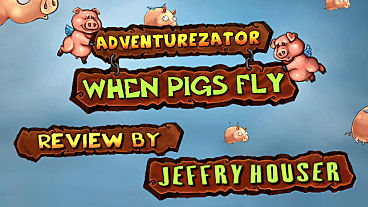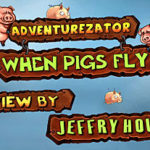
Adventurezator: When Pigs Fly Review
Unless you’re looking for a point-and-click way to create a derivative game with someone else’s graphics, I’d give it a pass.







Genre: Point-And-Click Adventure
Release date: September 17, 2015
Adventurezator is the most unique game I have ever played, and I wasn’t quite sure which standards I should be using to evaluate it. The game is a crowdfunded platform that allows you to create your own point-and-click adventure games. It is a game creator but also provides its own narrative and has the ability to download games others have created.
The first time I launched the game it went straight into the main story—called a campaign. It started with a cut scene and put you right into the first level. You play as Edmund, a merchant who cheated a wizard and was turned into a pig as a result. The purpose of the game is to collect the ingredients to reverse the spell.
The game world is laid out in a world map that made me think Super Mario 3. You see all the levels and can play any that you’ve unlocked. When you enter a level, you’re treated with an isometric view that reminded me of Ultima 6. I think this approach works really well and exploring each level is one of the game’s highlights. Each level is its own little world. The level screen gives you a list of goals, a list of your inventory items and a list of other playable characters. Each user interface element can be hidden from view so you’re able to see the level unobscured.
The second time I launched the game I got confused. Instead of sending me straight into the game it put me at a menu, and I had no idea what each section was. After some clicking I was able to determine what this meant. To get back to the game, I had to choose “campaign.” To play games others have created, I had to choose “scenario.” As best I could tell, a scenario is one level of a full campaign. The game comes pre-loaded with two scenarios independent of the main game and I found one more.
This game has lots of items and interactivity; however, I felt overwhelmed with each level. There are simply too many options. You can interact with everything in the world from trees to flowers, which makes it hard to discern what’s relevant. I can pick up the key from the table inside the house, but do I need it?
Also problematic is the control scheme, which has many facets that aren’t obvious. On one hand, it is point-and-click so you just point the mouse where you want to go and click. The character moves easily within the level. You’re also granted limited camera control. It can rotate left and right, but not up and down. Unfortunately, this feature isn’t covered in the in-game tutorial level, and I got quite frustrated trying to pick up a fish on a table behind a wall before discovering how to rotate the camera. The controls themselves are non-standard. In many 3D games I’m used to moving the character with the keyboard and controlling the camera with the mouse. This game implements the opposite.
Puzzles consist of collecting items, using “action” tables and talking to people. The game alludes to fighting as a feature, but my experience is that any fight you enter is instant death and sends you back to the beginning of the level. Even though a list of goals is laid out for you at the beginning, it’s not always obvious what’s meant or how to accomplish the goal. Making matters worse, I found the UI to be buggy and, at certain resolutions, the interaction buttons appear off-screen, making it impossible to complete the level. At first I thought it was me but after some trial-and-error I determined it wasn’t.
The main campaign is called When Pigs Fly. This is designed to be a demonstration of the game and engine and also teach you aspects of the game maker. The campaign is entertaining with a simple story, interesting characters, and a bunch of levels. But I found it more frustrating than fun. Some level goals seem obtuse and the game falls into the same “click until something happens” trap that many adventure games fall into. As mentioned above, for better or worse, everything in a level is clickable.
I couldn’t find much in the way of fan-made games with this engine, possibly because the game was just released. The game did come with two scenarios, each one like a single level game, and I did manage to find a fan-made scenario.
The first scenario is the Halloween prison break. It’s about a prisoner whose dying wish is to go back in time to prevent his death. It’s a creative idea, and I had fun walking around in the dungeon room and digging up graves. I really liked the skeleton character created in this game. Then I met the dog and the rest is history.
The second scenario is Pigasus Arena. You’re in the Arena to fight other characters. As I walked around I ran into two fights—the second one killed me. I wasn’t sure what the whole point of the scenario was, but it was at least a different approach to the game.
The third scenario is called The Princess Palavar, which I had to download on my own. The scenario uses characters from the main game and places you in a prison with two associates bent on escape. The level has a nice castle area to explore once you and your buddies manage to get out of the jail, but all three of the characters I could play died quickly by being at the wrong place at the wrong time and running into guards. It ended my play session quickly.
I spent an hour with the level creator before giving up exhausted. Creating your own characters is pretty easy; however, you’re limited to combining options that the game already offers. When I went in to design a level I became much more confused. I couldn’t figure out how to distinguish a character as the playable character; as a result, there was no one to control when I tried to play test levels.
Creating a level seems to work okay, and you can choose to place vegetation, paths, houses and people throughout the levels. You can also set goals and inventory items. However, you can’t bring in your own textures or layout of the land. The size of each level seems to be the same.
I don’t expect any serious game creators to spend time with this game, as there’s no ability to distribute your creation to users who haven’t already purchased this game. This limits the ability of a developer to distribute its creation to the world.
Adventurezator: When Pigs Fly has lots of potential; unfortunately, I have doubts it will ever be reached. The technology behind the game could be awesome with some tweaks, and I bet some wily developers could tell strong stories within the system. However, due to the limited customization of the game creation facilities, the lack of distribution options, and non-existent documentation, I don’t expect a large repertoire of games to be created with this engine. Unless you’re looking for a point-and-click way to create a derivative game with someone else’s graphics, I’d give it a pass.
|
+ The Isometric view is a different take on the Point-and-Click Adventure genre
+ The engine is flexible and could be used to build great stories
– The menu and controls are confusing, making it hard to control the game
– The engine is a bit buggy and at certain resolutions the interaction scheme is off-screen
– No ecosystem exists around fan-created games and I have no confidence one will ever develop
|

|
Processor: 1.7 GHz Dual Core
Memory: 4 GB RAM
Graphics: NVIDIA GeForce GTX 250, ATI Radeon 4870 HD, Intel HD 3000, or equivalent card with at least 512 MB VRAM
Processor: Intel Core Duo
Memory: 4 GB RAM
Graphics: ATI Radeon HD 4850, NVIDIA GeForce GT 250, Intel HD 3000, or equivalent card with at least 512 MB VRAM

Leave a Reply